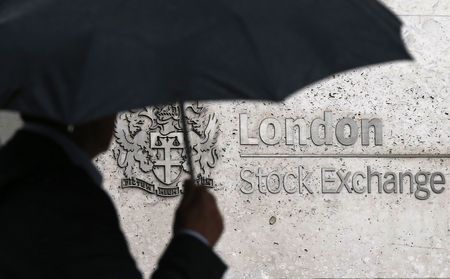(Reuters) -Britain’s FTSE 100 logged its steepest one-day fall in three weeks on Friday, led by losses in precious metals and mining and utilities, while Direct Line jumped after Aviva agreed to buy the insurer, lifting the mid-cap index.
The blue-chip FTSE 100 ended down 0.5%, while the midcap FTSE 250 was up 0.3%. Both indexes logged their third straight week of gains.
Direct Line jumped nearly 5.6% to be a top performer in the midcap index after insurer Aviva agreed to buy the smaller rival in a sweetened 3.61 billion pounds ($4.60 billion) cash-and-stock deal that will create the UK’s largest home and motor insurer.
Precious metals and mining <.FTNMX551030> led the losses, declining 1.7%, while utilities <.FTUB6510> fell 1.6%.
Personal goods jumped 2.1% to lead the sectoral gains.
Aviva shares fell 1.2%.
In contrast, Serco Group dropped the most on the midcap index with its 5.1% fall after UBS cut its rating on the outsourcing company to “sell” from “buy”.
Frasers launched a bid for Norwegian sporting goods retailer XXL ASA, saying it did not agree with the Oslo-listed company’s plan to issue more shares. Frasers dropped 3.6% to the bottom of the FTSE 100.
Spirax Group declined 2.9% after JP Morgan analysts downgraded the valve maker to a “neutral” rating from “overweight”.
Meanwhile, Britain’s property sector gathered more pace in November, with house prices rising by a faster-than-expected 1.3% in November from October to hit a record high.
Construction and materials were up 1%.
Britain’s business and trade minister Jonathan Reynolds said in an interview the country will think very carefully about retaliating if Donald Trump’s incoming administration hits the country with fresh tariffs.
Reynolds said he hoped that Britain would not be directly targeted by Trump, who has already pledged big tariffs on Canada, Mexico and China.
The Bank of England needs to cut interest rates further as its policy stance is still very restrictive, policymaker Swati Dhingra said.
Across the Atlantic, U.S. job growth surged in November, but a rise in the unemployment rate to 4.2% pointed to an easing labor market that should allow the Federal Reserve to cut interest rates again this month.
(Reporting by Nikhil Sharma and Sukriti Gupta; Editing by Janane Venkatraman and Shreya Biswas)
